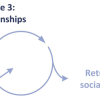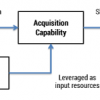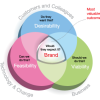Business Transformation Requires Transformational Leaders
Leadership and teaming skills are front and center in times of rapid change. Meet today’s constant disruption head on with expert guidance in leadership, business strategy, transformation, and innovation. Whether the disruption du jour is a digitally-driven upending of traditional business models, the pandemic-driven end to business as usual, or the change-driven challenge of staffing that meets your transformation plans—you’ll be prepared with cutting edge techniques and expert knowledge that enable strategic leadership.
Recently Published
This article presents a business-driven framework for digital transformation. This framework draws on contemporary thinking around the socialization of technologies, as well as practical experience from a large multinational corporation (Dell EMC) that is currently undertaking business-driven digital transformation via the introduction of a Global Business Services function.
Here we illustrate how an EA capability can contribute to an acquisition process by preparing the firm so it is ready to acquire, identifying value-creating possibilities, engaging in direct integration efforts, and monitoring the progress of work. Through our research and practical experiences, we’ve come to appreciate the value of enterprise architecture as an activity or action (the process of architecting) over that of a static framework (the concept of architecture), thereby focusing on the outcomes and impact of EA rather than the idea.
The digital world, with its liberal economy, innovative startups, universally accessible infostructure, and consumerized technology, is a heavy train racing toward any business stuck on the crossing between the past and the future. In this article, we attempt to provide readers with some orientation for the difficult — though in many respects also rewarding and exciting — journey of digital transformation.
The rush to find a solution to achieve business targets often overshadows the task of fully understanding the needs of customers and employees, which is vital to ascertaining where the real opportunity to create value lies. Management teams zoom in on cost reduction or revenue increases rather than what people will be able to do. Enhancing what people can accomplish is what delivers the benefits, and where there is sufficient demand for them, these benefits create commercial value. Therefore, to create value, organizations must start by focusing on outcomes — that is, the things that people are able to do. This enables management not only to prioritize, but also to communicate change in meaningful terms.
This article defines a framework for delivering a business-driven approach to digital transformation and provides an example of how articulating end-to-end stakeholder value delivery can help frame, scope, and prioritize digital transformation investments. In addition, it links digital transformation to strategic business objectives, ensuring that transformation is driven by the business. Finally, the article outlines the role of technology transformation as an extension of end-to-end strategy delivery.
Given the fast-changing business environment, large legacy organizations need to embark on a digital transformation journey to stay relevant and flourish. Specifically, they need to work with a business-driven framework that enhances business capabilities with architectural principles in mind so the business can adapt faster. Business architecture is a discipline that can help in this journey by bringing to the business the same rigor and adherence to architectural principles that IT has matured over the past few decades. While all of the architectural principles are critical in such a transformation, two specific ones — modularity and reconfigurability — are needed so the enterprise can adapt and respond quickly to a fast and continuously changing environment.
Our digital transformations need to succeed. In this issue of Cutter Business Technology Journal, we demonstrate how to approach them more comprehensively to ensure that they do. You will discover a couple of key themes across the articles. The first is the necessity of a top-down, business-driven approach to defining, designing, planning, executing, and measuring digital transformation in a coordinated way across the enterprise. The second requires us to rethink the way we manage the constant stream of change within our organizations altogether. Managing change is our new normal, and continuous innovation is no longer a differentiator but a core ability.
Businesses need to face the connected consumer-led economy with clear-cut imperatives that are aligned in lockstep with business and IT. Every prior enterprise transformation journey has been enabled by IT, but the digital technology transformative imperative changes the equation. Most digital transformations lose their way due to the complexity of overlapping boundaries at a high level between traditional and digital IT.



















